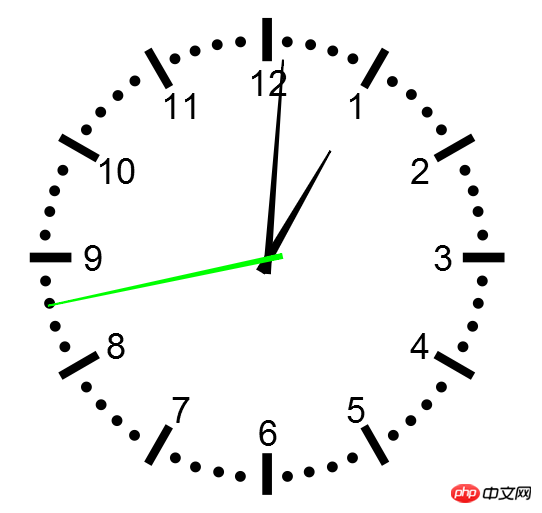Heim >Web-Frontend >H5-Tutorial >Wir stellen eine mit HTML5 Canvas erstellte Uhr vor
Wir stellen eine mit HTML5 Canvas erstellte Uhr vor
- 零下一度Original
- 2017-04-26 15:55:382350Durchsuche
Die mit HTML5 Canvas erstellte Uhr sieht recht einfach aus, aber es gibt immer noch viele kleine Probleme beim Schreiben, liebe Freunde kann sich auf
beziehen

Der Code lautet wie folgt:
<!DOCTYPE html>
<html lang="en" >
<head>
<meta charset="utf-8" />
<title>HTML5 时钟</title>
<link href="css/main.css" rel="stylesheet" type="text/css" />
<script src="http://code.jquery.com/jquery-latest.min.js"></script>
<style>
.clocks {
height: 500px;
margin: 25px auto;
position: relative;
width: 500px;
}
</style>
</head>
<body>
<header>
<h2>HTML5 时钟</h2>
</header>
<p class="clocks">
<canvas id="canvas" width="500" height="500"></canvas>
</p>
</body>
</html>[JavaScript]-Code
// inner variables
var canvas, ctx;
var clockRadius = 250;
var clockImage;
// draw functions :
function clear() { // clear canvas function
ctx.clearRect(0, 0, ctx.canvas.width, ctx.canvas.height);
}
function drawScene() { // main drawScene function
clear(); // clear canvas
// get current time
var date = new Date();
var hours = date.getHours();
var minutes = date.getMinutes();
var seconds = date.getSeconds();
hours = hours > 12 ? hours - 12 : hours;
var hour = hours + minutes / 60;
var minute = minutes + seconds / 60;
// save current context
ctx.save();
// draw clock image (as background)
ctx.drawImage(clockImage, 0, 0, 500, 500);
ctx.translate(canvas.width / 2, canvas.height / 2);
ctx.beginPath();
// draw numbers
ctx.font = '36px Arial';
ctx.fillStyle = '#000';
ctx.textAlign = 'center';
ctx.textBaseline = 'middle';
for (var n = 1; n <= 12; n++) {
var theta = (n - 3) * (Math.PI * 2) / 12;
var x = clockRadius * 0.7 * Math.cos(theta);
var y = clockRadius * 0.7 * Math.sin(theta);
ctx.fillText(n, x, y);
}
// draw hour
ctx.save();
var theta = (hour - 3) * 2 * Math.PI / 12;
ctx.rotate(theta);
ctx.beginPath();
ctx.moveTo(-15, -5);
ctx.lineTo(-15, 5);
ctx.lineTo(clockRadius * 0.5, 1);
ctx.lineTo(clockRadius * 0.5, -1);
ctx.fill();
ctx.restore();
// draw minute
ctx.save();
var theta = (minute - 15) * 2 * Math.PI / 60;
ctx.rotate(theta);
ctx.beginPath();
ctx.moveTo(-15, -4);
ctx.lineTo(-15, 4);
ctx.lineTo(clockRadius * 0.8, 1);
ctx.lineTo(clockRadius * 0.8, -1);
ctx.fill();
ctx.restore();
// draw second
ctx.save();
var theta = (seconds - 15) * 2 * Math.PI / 60;
ctx.rotate(theta);
ctx.beginPath();
ctx.moveTo(-15, -3);
ctx.lineTo(-15, 3);
ctx.lineTo(clockRadius * 0.9, 1);
ctx.lineTo(clockRadius * 0.9, -1);
ctx.fillStyle = '#0f0';
ctx.fill();
ctx.restore();
ctx.restore();
}
// initialization
$(function(){
canvas = document.getElementById('canvas');
ctx = canvas.getContext('2d');
// var width = canvas.width;
// var height = canvas.height;
clockImage = new Image();
clockImage.src = 'http://static.oschina.net/uploads/space/2012/0712/125855_nnla_89964.png';
setInterval(drawScene, 1000); // loop drawScene
});Das obige ist der detaillierte Inhalt vonWir stellen eine mit HTML5 Canvas erstellte Uhr vor. Für weitere Informationen folgen Sie bitte anderen verwandten Artikeln auf der PHP chinesischen Website!
Stellungnahme:
Der Inhalt dieses Artikels wird freiwillig von Internetnutzern beigesteuert und das Urheberrecht liegt beim ursprünglichen Autor. Diese Website übernimmt keine entsprechende rechtliche Verantwortung. Wenn Sie Inhalte finden, bei denen der Verdacht eines Plagiats oder einer Rechtsverletzung besteht, wenden Sie sich bitte an admin@php.cn
Vorheriger Artikel:Teilen Sie einen einfachen Beispielcode für die Einbettung eines HTML5-VideosNächster Artikel:Teilen Sie einen einfachen Beispielcode für die Einbettung eines HTML5-Videos
In Verbindung stehende Artikel
Mehr sehen- Das Vollbild-Bildlauf-Plug-in AlloyTouch erstellt in 30 Sekunden eine flüssige H5-Seite
- Tatsächlicher HTML5-Kampf und Analyse von Touch-Ereignissen (Touchstart, Touchmove und Touchend)
- Ausführliche Erläuterung der Beispiele für Bildzeichnungen in HTML5 Canvas 9
- Reguläre Ausdrücke und neue HTML5-Elemente
- So kombinieren Sie NodeJS und HTML5, um mehrere Dateien per Drag-and-Drop auf den Server hochzuladen

